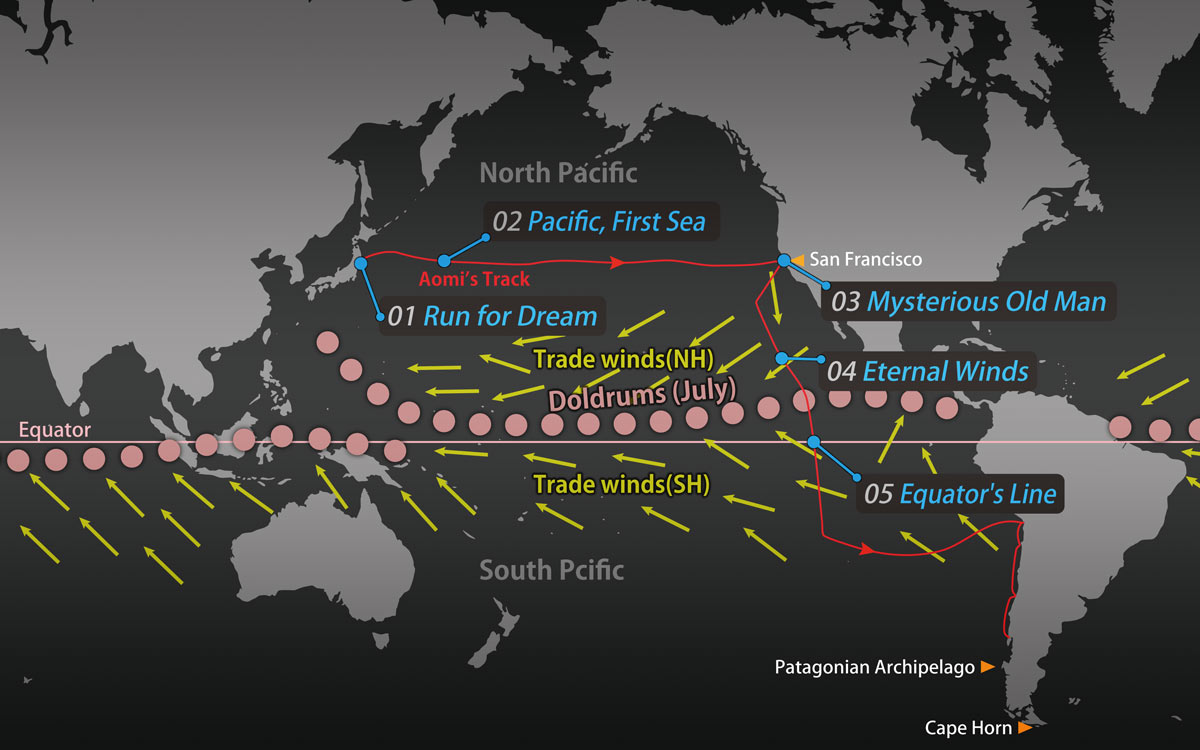04. Eternal Winds
Everyone carries memories of unforgettable scenery: the breathtaking sights of a travel destination, the familiar views of a childhood hometown, and the lasting images of mountains, rivers, and seas that stay with you for life.
For me, the vivid sight of the Trade Wind Zone is one of them.

A ball of light, half-submerged in the tropical sea, blinds you if you look directly at it: a mass of intense orange glow.
The vast bowl of sky, as if turned upside down over the ocean, is tinted with the sunset colors from the horizon to overhead. The scattered clouds have already turned black, like cotton-wool shadows.
As soon as the sun dips below the horizon—nearly two minutes after sunset begins—a blue-violet curtain rises from the horizon behind me. The landscape soon deepens into indigo, and stars begin to shine overhead.
These massive changes in light and color, as if cast by a projector onto the sky’s vast canvas, make me almost hold my breath. I stare at it until my neck hurts, just like I did in elementary school.
Half a month after departing San Francisco, Aomi is now in tropical waters, having sailed about 2,000 kilometers south across the Pacific.
The trade winds blow day and night with steady strength and direction over the brilliant sea of eternal summer. Under a clear sky and blazing sun, the following wind fills the sails. The blue sky resembles a child’s drawing, dotted with torn, cotton-like cumulus clouds.
The wind blows at force three on the Beaufort scale, and the waves rise only a few tens of centimeters. Aomi sails swiftly, accompanied by the refreshing sound of water rushing along her hull. The warm wind brushing my bare skin is unbearably pleasant. It is so pleasant I almost scream. I have never known such a gentle and happy sea.
There is nothing on the water around me: no islands, no ships, no birds. Only the trade winds, blowing without pause.
When did this wind start blowing, and when will it stop? Maybe it has been blowing forever.
For tens of thousands of years, the trade winds must have swept across these seas just as they do now. Perhaps nothing has changed, not even the burning sun overhead or the cumulus clouds on the horizon. The fact that humans have built civilizations and fought many wars throughout history has nothing to do with the view in front of me.
There is no distinction between present and past, not even a hint of which era it is. On the sea, where the trade winds constantly blow, the sun has risen and set, again and again, endlessly since ancient times.
Perhaps nothing has changed here.
In fact, time seems to have frozen. The first sailors who came here hundreds of years ago during the Age of Discovery must have looked at the same clouds, watched the same sunsets, and thought the same things I do.
What century am I in, all alone at sea? It would not be strange if I saw a pirate ship from a distant age on the horizon.
Further south lies the next encounter: the Equatorial Doldrums, just beyond the Trade Wind Zone.
It is by no means a windless sea. Trade winds from the Northern and Southern Hemispheres collide here and rise as updrafts. It is a long east–west band, several hundred kilometers wide from north to south. It is also a place of unstable weather, with fickle winds coming and going.
Almost every day, squall clouds accompanied by gusty winds visit the calm, swell-free sea, releasing large drops of passing rain.
Shivering naked in the unexpectedly cold tropical rain, I catch the water dripping from the sails in a bucket at the foot of the mast, then pour it into a small plastic tank. I add a few drops of chlorine disinfectant solution to the bucket, for use as drinking water.
After the passing rain, calm returns, leaving Aomi motionless on the windless, waveless sea for half a day or even longer.
Some days, sharks circle around Aomi, cutting through the water with their dark, pointed fins rising above the surface. Through the crystal-clear azure water, I can see their sleek, gray bodies, like jet fighters.
Some sharks can grow as large as whales, reaching lengths of over 18 meters. I once heard a story about a sailboat colliding with a shark, from a man who was actually on board at the time.

Oceanic sharks are said to be forced to swim constantly because they cannot breathe if they stop. From the moment they are born, they are fated to move day and night until they die—just like us, living our lives in the never-ending rush of each day, pressed for time, within the herd of humans we call “the City.”

Hi! Any questions or suggestions about the content are greatly appreciated.
I’d also love writing tips from native English speakers. Since English isn’t my first language, if you notice any awkward phrases or anything that seems off, please let me know.
Thank you!
E-mail